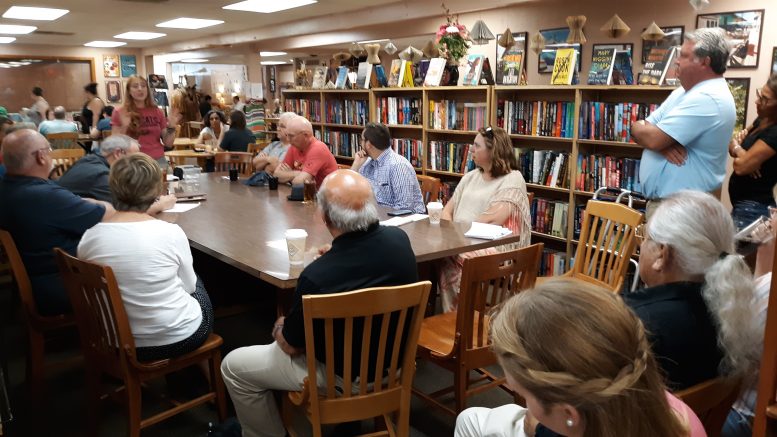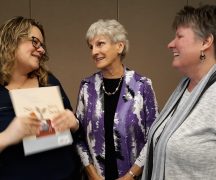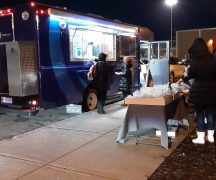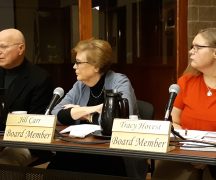By JAN LARSON McLAUGHLIN
BG Independent News
The Save Our Schools citizens group wants Bowling Green City Schools to get one message loud and clear.
“We want to keep our little schools,” said organizer Kathleen Pahl.
“I think we need to send a loud and clear message, because we don’t want a consolidated elementary,” Pahl said to about 25 citizens who gathered at Grounds for Thought for the inaugural meeting of the group Tuesday evening.
“We’ve already voted two times on this,” she said of the school elementary bond issue. The issue on the November ballot will be different this time – since it combines a property tax and income tax; only addresses the elementary needs; and is for $40 million rather than $72 million.
But the one similar factor is that one consolidated elementary building is again being planned to replace the existing three elementaries.
“Our message is obviously not loud and clear enough. When it fails for the third time, they will get the message,” Pahl said.
But the two citizens who spoke up during the brief meeting Tuesday voiced support for one consolidated elementary.
Meg Carek, who lives in Bowling Green and worked as a nurse for Elmwood School District, talked about the experience of that district.
“I saw the resistance to a consolidated elementary school,” Carek said, recalling the three tight village schools that were consolidated into one. Though many opposed the plan, the school and Elmwood community benefitted, she said.
“There was so much spirit. The whole community came together,” Carek said. “It was just such a positive.”
But supporters of the “neighborhood school” concept argued that a consolidated elementary may work with smaller districts – but would be too big in the case of Bowling Green, where 1,200 to 1,500 students would be at one site.
“Why do the numbers make a difference,” Carek asked.
After the meeting, Carek talked about the success of the consolidation of districts like Elmwood and Otsego, where the teachers have more support, parents are more involved, and the schools are more economical to operate.
“I see the schools that made that choice moving ahead,” she said. “They love it.”
Also speaking in favor of the consolidation plan was Wayne Colvin, who responded to a question about the recommendation of the school facilities task force. Colvin explained that the majority of the task force members favored a consolidated elementary as the best for students and taxpayers. However, a majority of the members also said the community would be most likely to support three separate elementary schools.
Pahl explained her motivation for starting the Save Our Schools organization.
“I feel like it was important to speak out on the consolidation of the schools,” she said.
As the mother of two children, ages 7 and 9, Pahl said she “fell in love with the community” after attending college here.
Pahl said her research identified “a lot of flaws” in the educational system. She prefers the Montessori educational process – and would like to see public education steer in a direction similar to that.
Her children attend Crim Elementary.
“I want other kids to have that opportunity that mine had,” Pahl said.
Money isn’t the issue, she explained.
“I would rather pay a little bit more to keep neighborhood schools,” Pahl said.
“There are a lot of good reasons for neighborhood schools,” she said.
After the meeting, Pahl listed off the benefits of smaller schools as creating more community involvement, with more neighborhood and community interaction for the students.
“Schools are the neighborhood hub for the community,” she said. “Bowling Green is starving for community.”
When asked if it is the responsibility of students to create a feeling of community, Pahl said it is a shared responsibility of city and school to create neighborhoods.
Other districts with similar demographics to Bowling Green have found that smaller neighborhood schools are worth the investment, she said. There are none in Wood County, but throughout the state, such as in Athens, Kent and Oxford, she said.
Pahl also acknowledged that no studies exist showing that smaller neighborhood schools produce better educations than larger consolidated schools – and vice versa.
But with Ohio school funding making it difficult for districts to thrive, Pahl said the consolidation movement may just be a fad.
“These school districts are forced to come up with solutions,” she said. “I feel like this is a short-term fix.”
School officials have said consolidating the elementaries into one building will allow for more sharing of educational resources and more equitable opportunities for students.
Pahl said that equity should be available in smaller elementaries.
“I truly believe that can be established in each and every school,” she said. “When schools are smaller, teachers know all the students. You lose that in a consolidated school.”
Pahl again spoke of the Montessori education model and the system used in Finland.
“I want public education to move in these creative directions,” she said.
Future “Save Our Schools” meetings will be more informational, Pahl said. One topic may focus on the “Safe Routes to School” program, which provides resources for schools encouraging walkers and bikers to school.





